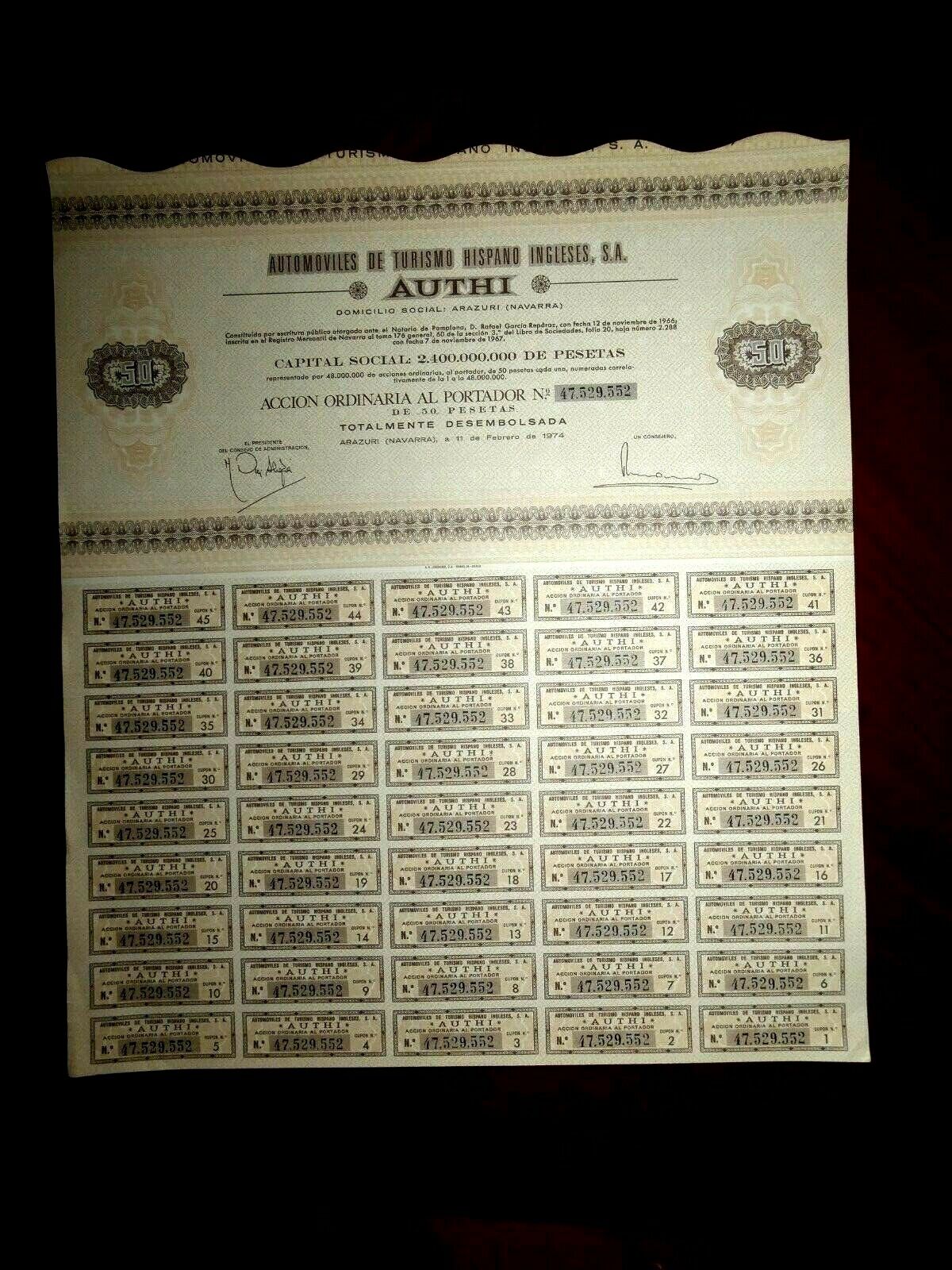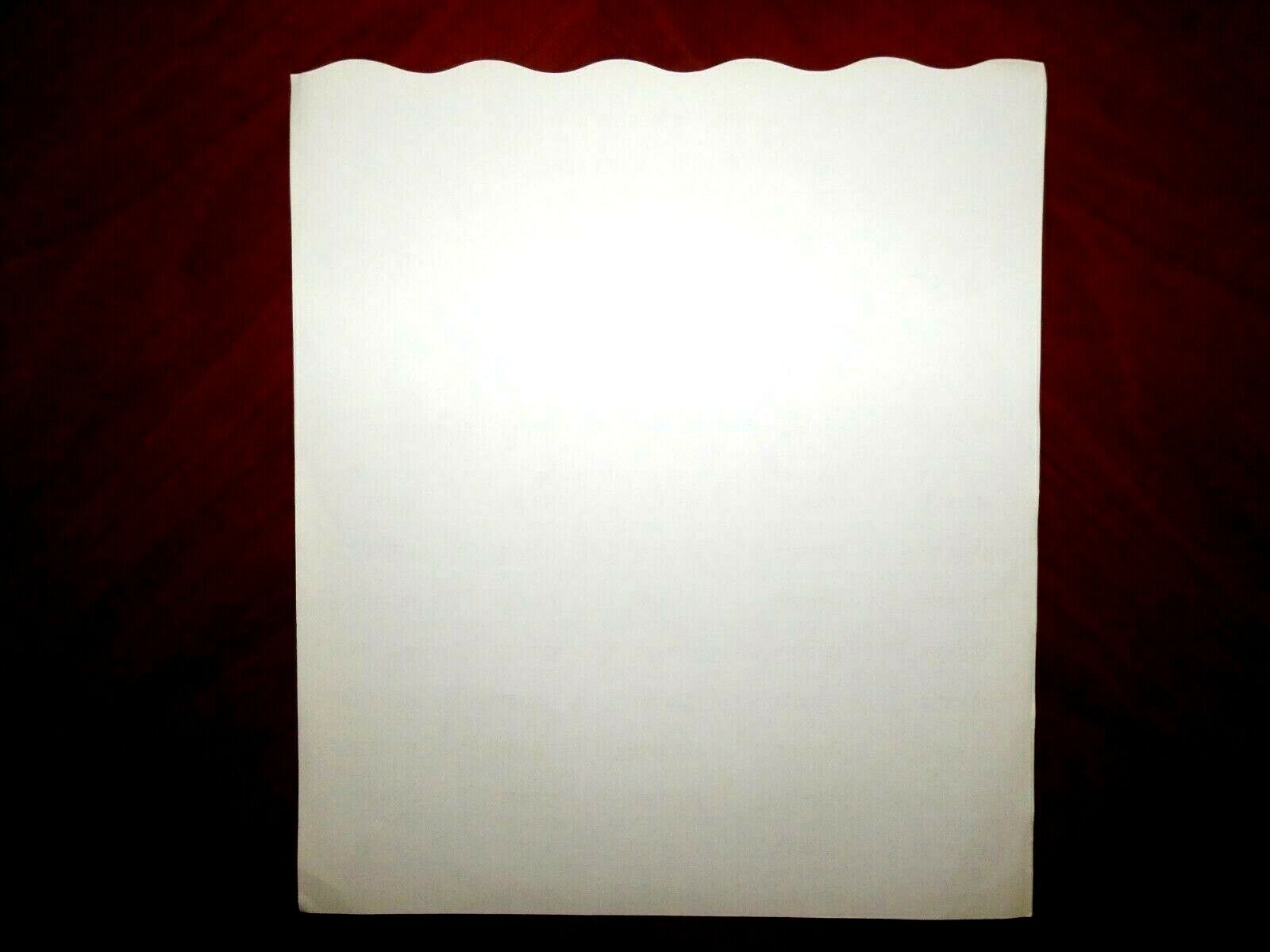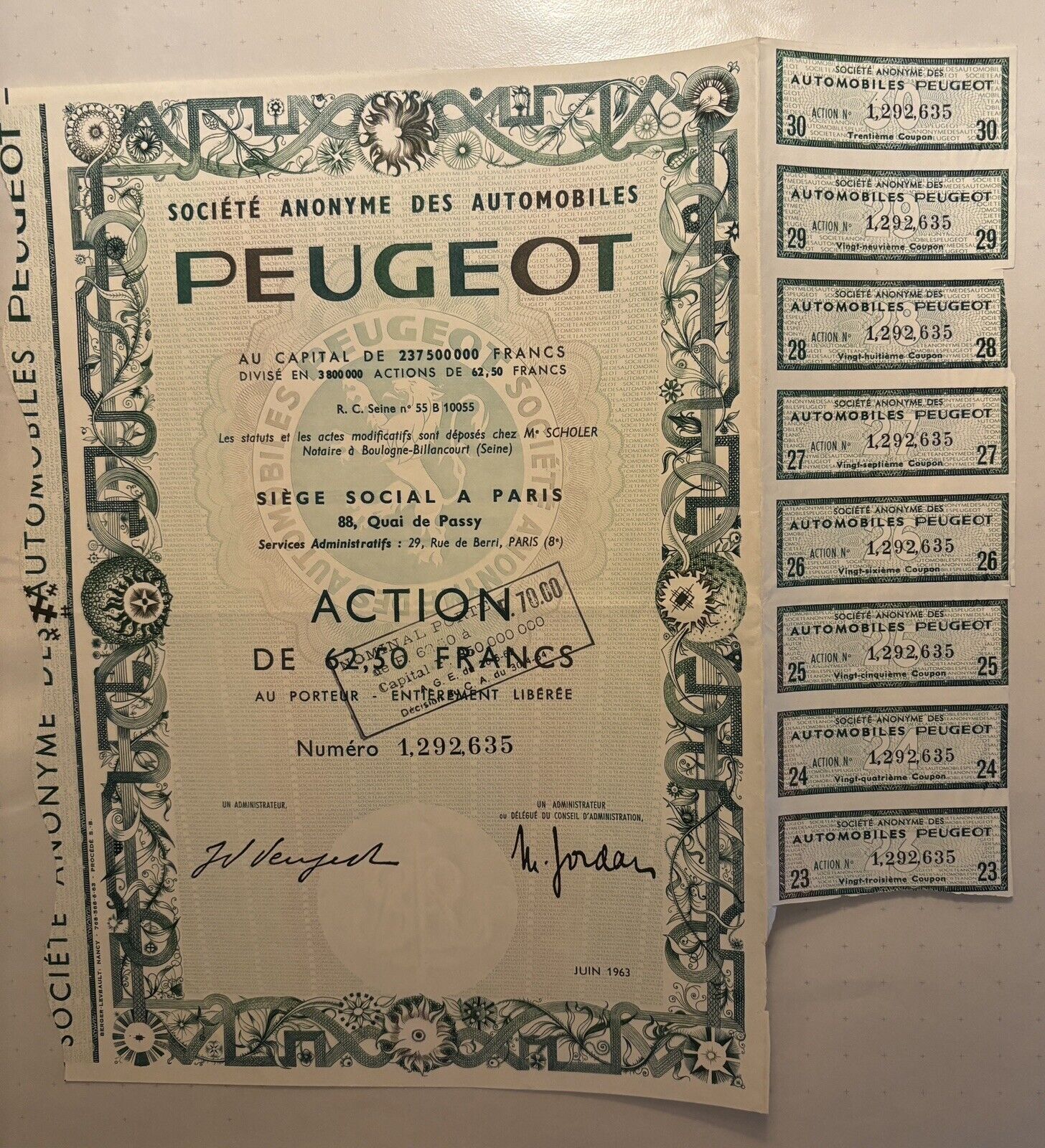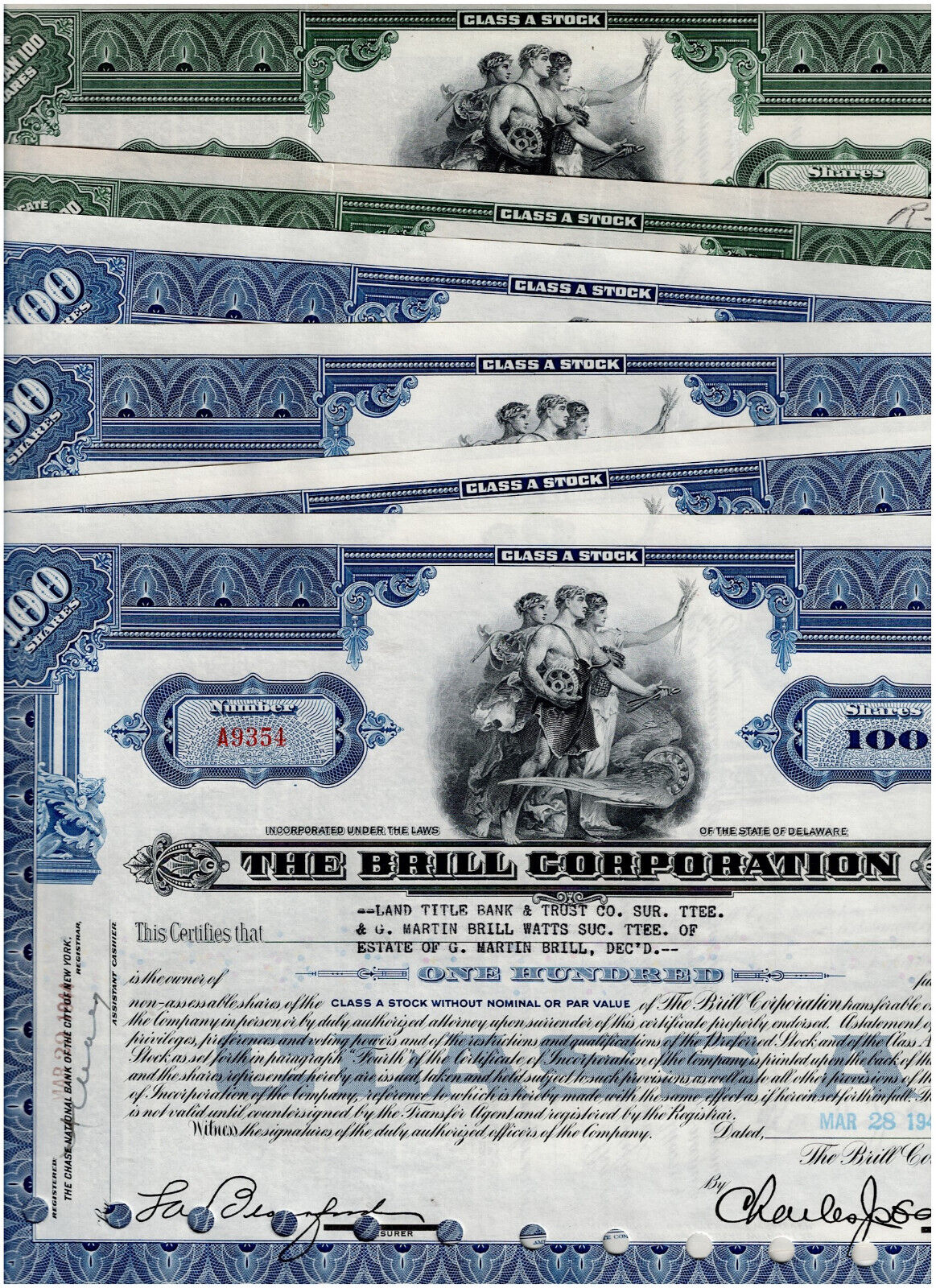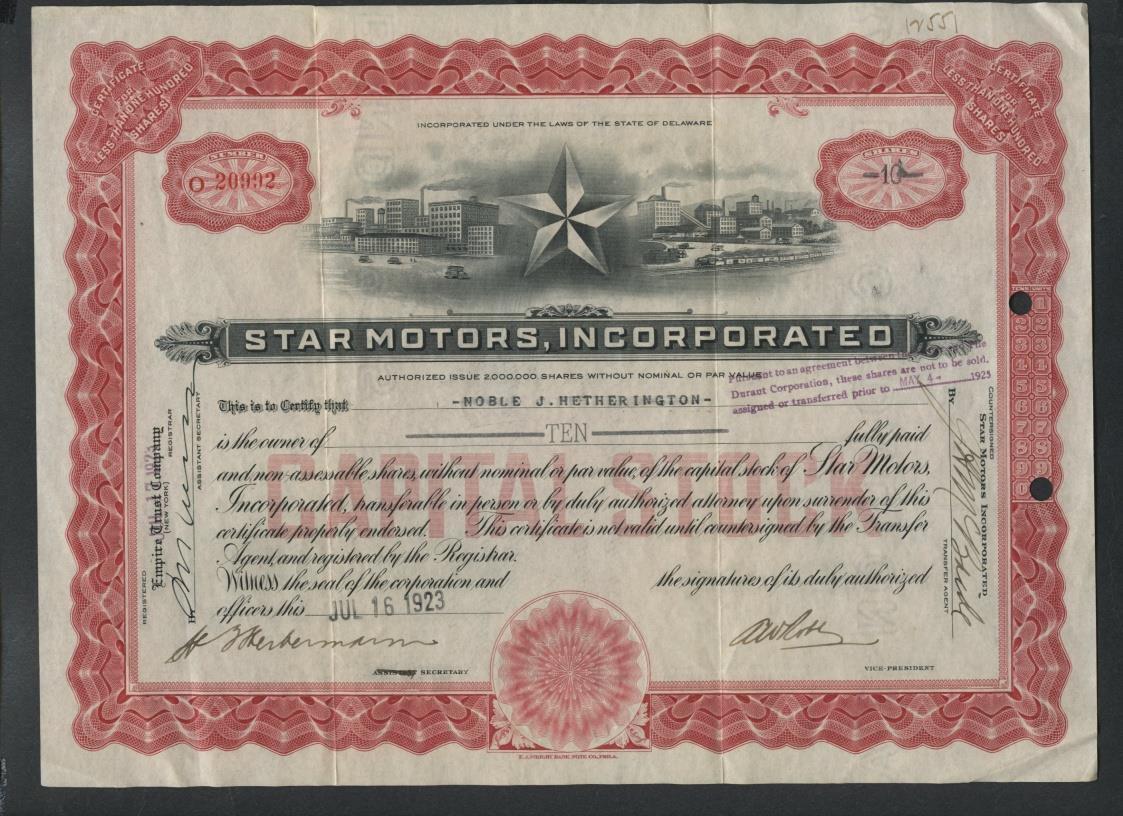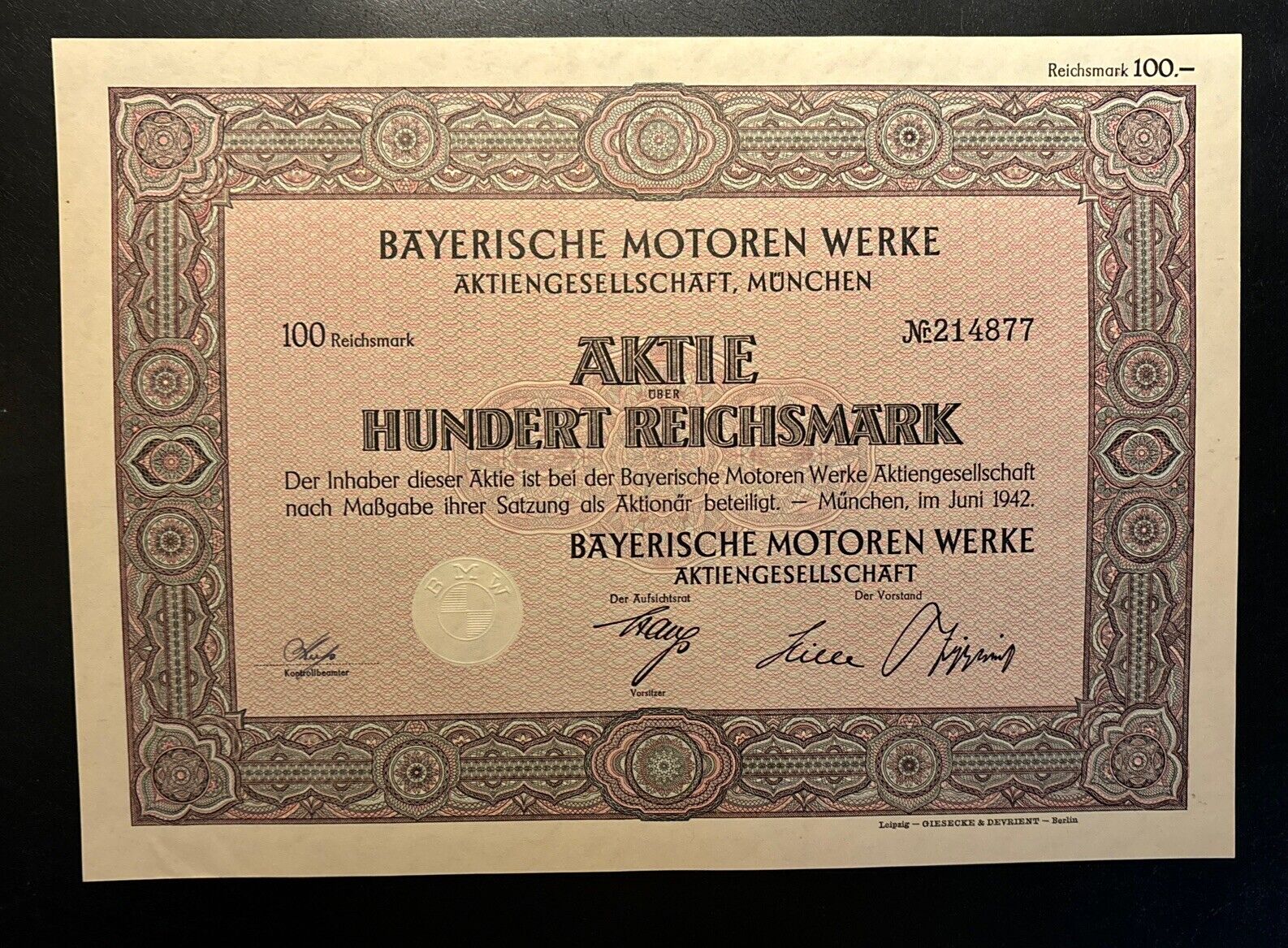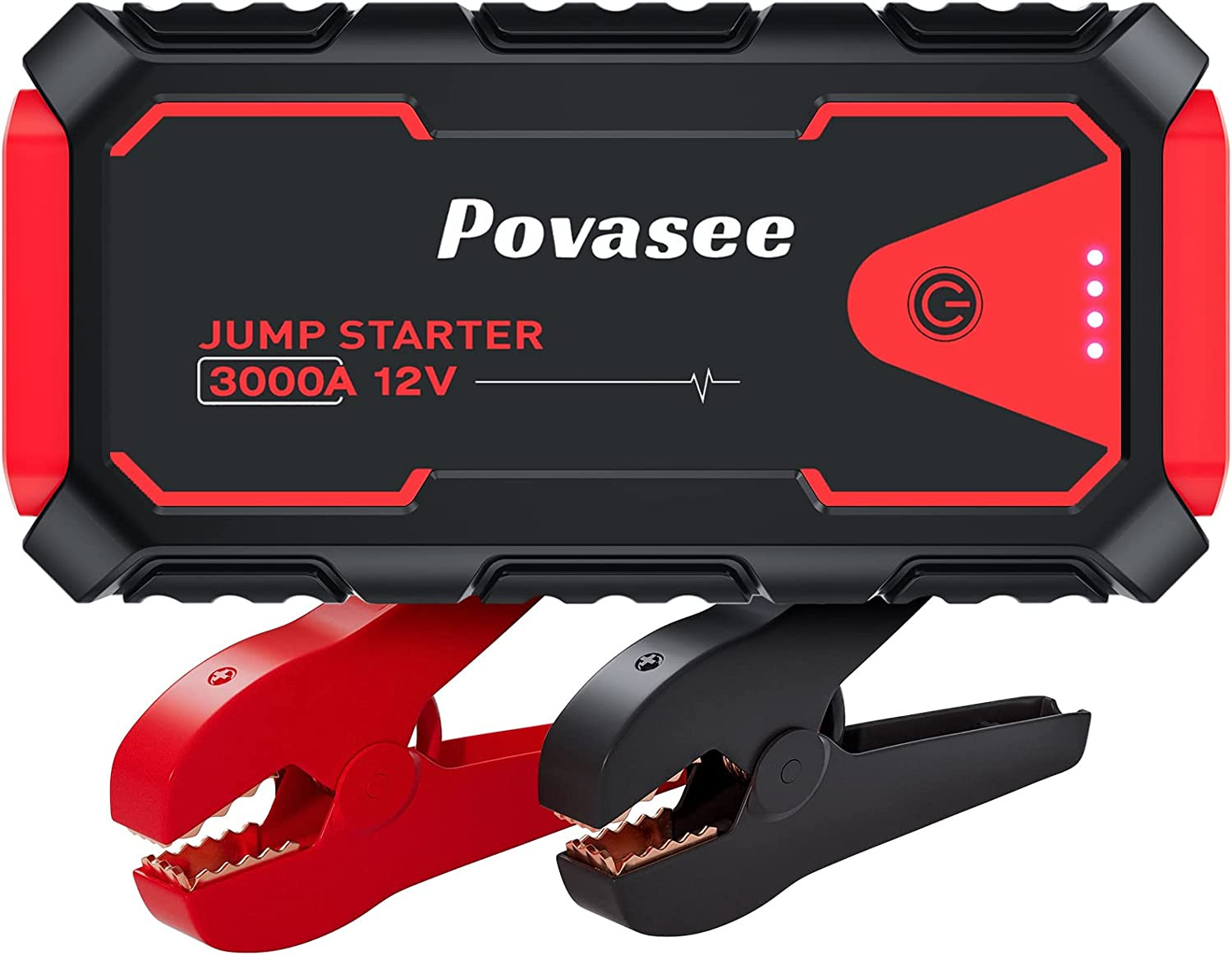-40%
Automoviles Turismo Hispano Ingleses AUTHI 1974 Share Certificate
$ 3.9
- Description
- Size Guide
Description
One bearer share certificate of the "AUTOMOVILES DE TURISMO HISPANO INGLESES SA " (AUTHI) Arazuri(Navarra) Spain 1974 . Condition (opinion) :Very Fine (VF) .Share capital 2.400 Million Pesetas,value 50 pesetas .Established in 1966. Remain uncancelled and with all the 45 dividend coupons uncut .Printer AG Lerchundi sa ,Bilbao. The factory of the "Mini" cars Mini-Morris ,Mini-Cooper .See more information from the web below in Spanish and English (below Spanish text and photos,traslated online).BREVE HISTORIA DE AUTHI Y LOS MINI FABRICADOS EN ESPAÑA.
La sociedad AUTHI S.A.( Automóviles de Turismo Hispano Ingleses S.A.) nace oficialmente el 12 de noviembre de 1966 con un capital de 200 millones de pesetas y estaba formada principalmente por la Compañía Nueva Montaña Quijano, firma santanderina de larga tradición en España Esta Compañía fabricaba desde 1956, muchos elementos y componentes para FASA-RENAULT
Cuando años después FASA-RENAULT, deja de comprar dichos componentes, se pensó pronto en la BMC como la firma con la que fabricar algunos de sus modelos como el
MINI
y el MORRIS 1.100.
Fueron el Marqués de Huidobro por la Compañía AUTHI y George Harrriman por la BMC quienes finalmente firmaron el acuerdo entre ambas Compañías.
Se decidió la construcción de una fábrica en la localidad navarra de LANDABEN cerca de PAMPLONA, en donde inicialmente se construirían los MORRIS, los MG, y poco tiempo después los
MINI
.
En cuanto a la elección de NAVARRA, fue por sus peculiaridades fiscales en aquella época, además estaba bien comunicada con el País Vasco, Aragón y Cataluña,
Los terrenos de LANDABEN, ocupaban 446.000m2, de los que 200.000 estaban construidos al iniciar las actividades. El tiempo de construcción de la fábrica fue de tan solo 14 meses.
Por entonces, Nueva Montaña Quijano, aún seguía sirviendo a FASA-RENAULT, por lo que ampliaron sus instalaciones también para servir a AUTHI. Así en Santander se fabricaría el conjunto de motor-transmisión.
En marzo de 1968,se realiza el lanzamiento del MORRIS TRAVELLER, en LANDABEN estando presente toda la plana mayor de AUTHI, es decir su Presidente el Marqués de Huidobro , el Director D. José Mir, su adjunto D. Ignaio del Burgo, el Director Comercial D.Santiago Corral, y el responsable de Publicidad y Relaciones Públicas D. Michael Cheetman.
La cadena de producción tenía entonces la capacidad para construir 40 coches/hora. La integración nacional iba aumentando, así por ejemplo la fabricación de la suspensión hydrolastic era fabricada por DUNLOP en BILBAO. También en Cataluña, concretamente en MANRESA se fabricaban diversos componentes.
En 1969, se confirma la fabricación de los
MINI
, se anuncian para el tercer/cuarto trimestre del año en curso los modelos 1.275 y 1000 c.c. con un precio de 125.000 y 92.500 franco fábrica.
El 14 de abril de 1969, se presentan en el Feria de Barcelona, Sector del Automóvil, los
MINI 1000-E y S( Standard
).
El 7 de julio de 1969, la BLMC compra el 51% de AUTHI, y pasa a ejercer su control. El grupo inglés aumenta notablemente el capital social que pasó de 200 a 1.470 millones de pesetas, y se habló de mejorar la calidad de la producción, la red comercial, y el servicio postventa, también se pensó en la exportación. Mientras en Inglaterra se celebraba la salida del
MINI
inglés nº 2.000.000.
Curiosamente en España, el
MINI
850 fue el último modelo en salir, concretamente fue en febrero de 1970 y con un precio de 80.000 pesetas.
En 1971, en el Sector del Automóvil de la Feria de Muestras de Barcelona, se presenta otra versión, el
MINI VAN
en las cilindradas de 850 y 1.000 c.c.
En 1972, se realiza la presentación del AUSTIN 1.100 y del VICTORIA .
Por aquel entonces, económicamente AUTHI no iba bien y la BLMC procede a comprar la totalidad (98,4%) de AUTHI, pero esto no mejoró los resultados de la fábrica de LANDABEN.
En diciembre de 1973, AUTHI, presenta el modelo
MINI COOPER 1.300.
En1974, el capital social de AUTHI, alcanza ya los 2.400 millones de pesetas, y presentan el modelo AUSTIN DE LUXE.
El 9 de octubre de 1974, acontece un suceso lamentable, es el grave incendio de la factoría, al parecer suceso totalmente fortuito y que ocasiona pérdidas por valor de 500 millones de pesetas, y deja en el paro a 1.700 empleados.
Se intenta salvar a AUTHI, creando un Consorcio entre SEAT, CITROEN Y RENAULT, pero no fue posible llegar a un acuerdo. Aún así , AUTHI, da señales de vida y en abril de 1975 procede a liquidar los coches en stock, a precios de catálogo y que continúan fabricando, eran tiempos difíciles para AUTHI, que estaba entonces presidida por D. Manuel Díez –Alegría.
Finalmente el Gobierno insta al INI para que vía SEAT se haga cargo de la fábrica de LANDABEN. En mayo de 1975, dejan de fabricar restando como única actividad la comercialización de las unidades del stock. Los coches de AUTHI, están presentes en las listas de precios hasta 1976.
En julio de 1975 se llegó a un acuerdo entre BLMC y SEAT y el precio pagado fue al parecer de 1.250 millones de pesetas. LANDABEN pasa a ser controlada por SEAT, cambiando el equipo gestor e iniciando la fabricación del SEAT –124 (Febrero de 1976).El equipamiento de la fábrica entonces era muy moderno, cuando VW compró SEAT.
Anteriormente en la época de SEAT, habían fabricado además de otros modelos SEAT, los LANCIA 2000 coupé y HPE, al ser LANCIA una firma del Grupo FIAT.
Así pues, de esta factoría navarra de LANDABEN, han salido coches bajo las marcas de MORRIS, MG,
MINI
, AUSTIN, SEAT, LANCIA, VW.
Por lo tanto, LANDABEN ES SIN DUDA ALGUNA, UNA FÁBRICA CLAVE PARA ENTENDER GRAN PARTE DE LA HISTORIA DEL AUTOMOVÍL EN ESPAÑA DE
LAS ULTIMAS DÉCADAS DEL SIGLO XX.
(Resumen de la publicación : Authi y los Mini españoles .Colección “Nuestros coches” Primera edición nov. 1977. Por D. Pablo Gimeno Valledor y Ramón Roca Maseda.)
BREVE HISTORIA DE BRITISH LEYLAND AUTHI EN ESPAÑA.
¿ Quién es British Leyland?
La British Leyland era en 1971 el mayor fabricante inglés de vehículos. Así lo demuestra la cifra de automóviles vendidos en aqurel año que alcanza la cifra de 1.057.000 que suponen 198.000millones de pesetas. Entre los vehículos que componen su gama están:
Austin 1.100-Austin 1.300- Morris Marina- Austin 3 litros- Triumph- Rover- Mini- Jaguar-Daimler.
BRITISH LEYLAND AUTHI.
En 1965, la empresa Nueva Montaña Quijano llegó a un acuerdo con British Motor Corporation, miembro del Grupo British Leyland, para construir bajo licencia los vehículos Austin y Mini en España.
La fabricación en serie comenzó en 1967. En 1969, British Leyland adquirió el 50% del capital de Authi, con lo que ésta pasó a formar parte de British Leyland, primer fabricante inglés de vehículos y uno de los más fuertes del mundo.
LAS FACTORÍAS DE BRITISH LEYLAND AUTHI EN ESPAÑA.
-Los Corrales de Buelna (Santander).
Tiene una superficie total de 136.000 metros cuadrados , de los cuales 48.700 son cubiertos. El taller de fundición, de 12.300 metros cuadrados , tiene una capacidad de 40 toneladas útiles diarias en fundición de hierro y aluminio .El taller de mecanizado y montaje de motores, con una superficie de 17.300 metros cuadrados , puede producir en un solo turno,125 unidades completas con caja de cambio.
El taller de mecanizado y montaje de transmisiones y suspensiones tiene una superficie de 6.384 metros cuadrados y una capacidad de 125 conjuntos al día.
Como complemento existe el taller de estampación de Santander, apto para una producción equivalente a 40.000 coches al año y que se amplió hasta 50.000.
El total de personal de este grupo de fábricas es de 2.148 personas.
-Pamplona (Navarra).
La fábrica de montaje está enclavada en un valle en Arazuri, en las cercanías de Pamplona.. Se encuentra dentro del Polígono industrial denominado Landaben, ocupando un superficie de medio millón de metros cuadrados, de los que se hallan construidos 60.500.
Está formada por tres grandes naves, donde se realizan el ensamblado, el pintado y el montaje de guarnecidos y conjuntos mecánicos. El montaje discurre por dos cadenas independientes, una dedicada a los diversos modelos de MINI, y la otra al MG, AUSTIN, y COUNTRYMAN.
La longitud de ambas cadenas es de 4.000 metros .
Existe una pista de pruebas con un recorrido de 1.800 metros , en forma de ocho, construída con distintos peraltes y adicionada con una zona mal pavimentada para detectar ruidos y otra para la prueba de frenos.
Un apeadero de ferrocarril permite la expedición de los coches por este medio de locomoción.
Cuenta también con instalaciones para otros servicios como : oficinas, central térmica ,taller, escuela, etc. El personal de esta factoría alcanzaba la cifra de 1.424.
-Manresa (Barcelona).
La superficie de Grupo es de 120.000 metros cuadrados , de los que está cubiertos unos 22.000.
Este grupo de factorías, se dedica ala fabricación de piezas embutidas y troqueladas de chapa, subchasis, parachoques, carburadores, bombas de agua, cerraduras, asientos y pequeño material auxiliar.
En este Grupo trabajan 361 personas.
-Valladolid.
Esta factoría era muy moderna entonces y estaba situada en el Polígono de Argales.
Ocupaba una superficie de 4.000 metros cuadrados , con un edificio de dos plantas y dos naves, una destinada a la fabricación de asientos para los vehículos fabricados y contando con una plantilla de 71 persona.
• San Fernando de Henares (Madrid).
Instalaciones modernas entonces ,y situadas a 18 km . de Madrid, ocupando una superficie total de 11.200 metros cuadrados . Las dependencias más significativas son las constituidas por oficinas, escuelas de formación y almacén de repuestos, éste último con una superficie de 3.600 metros cuadrados . La razón de instalar el almacén en Madrid fue para posibilitar un servicio de
envío más rápido en toda España.
MINI COOPER 1300 - MINI VAN
MINI VAN
MINI 1000 B
MINI 1000 B
MINI 1275 GT
AUTHI Society SA (cars Hispano Ingleses SA) officially born November 12, 1966 with a capital of 200 million pesetas and was formed primarily by the Company Nueva Montaña Quijano, Santander firm with a long tradition in Spain This Company manufactured from
1956, many elements and components for FASA-RENAULT
When years later FASA-RENAULT, stop buying those components, it was thought early in the BMC as the firm with which manufacture some of its models like the MINI and MORRIS 1100.
They were the Marquis de Huidobro by the Company and George Harrriman AUTHI the BMC who finally signed the agreement between both companies.
It was decided to build a factory in the town near LANDABEN Navarra PAMPLONA, where initially build the Morris, MG, and soon after the MINI.
As for the choice of Navarre, was because of its peculiarities tax at that time, he was also well connected to the Basque Country, Aragon and Catalonia
LANDABEN grounds, occupied 446.000m2, of which 200 000 were built to initiate activities.
The time of construction of the factory was just 14 months.
By then, Nueva Montaña Quijano, was still serving FASA-RENAULT, so also expanded its facilities to serve AUTHI.
So in Santander would be built all motor-transmission.
In March 1968, the launch takes place MORRIS TRAVELLER in LANDABEN being present all the staff of AUTHI, namely the President, the Marquis de Huidobro, the Director D.
José Mir, his deputy D.
Ignaio del Burgo, the Sales Manager Mr. Santiago Corral, and is responsible for Advertising and Public Relations D.
Michael Cheetman.
The production line was then able to build 40 cars per hour.
National integration was increasing, so for example the manufacture of the suspension was made by DUNLOP hydrolastic in BILBAO.
Also in Catalonia, specifically in MANRESA various components were manufactured.
In 1969, confirms the production of the MINI, are announced for the third / fourth quarter of this year the 1275 and 1000 cc models
with a price of 125,000 and 92,500 works.
On April 14, 1969, are presented in the Feria de Barcelona, Automotive Sector, the MINI E and 1000-S (Standard).
On July 7, 1969, the purchase BLMC AUTHI 51%, and goes on to exercise its control.
The English group greatly increases the social capital that went from 200 to 1,470 million pesetas, and spoke of improving the quality of production, sales network and after sales service is also thought to export.
While England celebrated the departure of the English MINI No. 2,000,000.
Curiously, in Spain, the MINI model 850 was the last to leave, specifically was in February 1970 with a price of 80,000 pesetas.
In 1971, the Auto Industry Exhibition Fair in Barcelona, there is another version, the MINI VAN in displacements of 850 and 1,000 cc
In 1972, he made the presentation of the 1100 and VICTORIA AUSTIN.
At that time, economically AUTHI was wrong and BLMC proceeds to buy all (98.4%) of AUTHI, but this did not improve the results LANDABEN factory.
In December 1973, AUTHI unveiled the 1300 MINI COOPER.
En1974, the capital of AUTHI now reached 2,400 million pesetas, and present the model AUSTIN DE LUXE.
On October 9, 1974, a sad event happens, is the serious fire at the factory, apparently entirely fortuitous event that causes losses worth 500 million pesetas, leaving 1,700 unemployed workers.
AUTHI is trying to save, creating a consortium between SEAT, Citroen and Renault, but it was not possible to reach an agreement.
Still, AUTHI is alive and in April 1975 proceeds to pay off the cars in stock, at list prices and continue to manufacture, they were difficult times for AUTHI, which was then chaired by D.
Manuel Díez-Alegría.
Finally, the Government urges the INI to take over via SEAT factory LANDABEN.
In May 1975, stop making the sole activity by subtracting the marketing of the units in stock.
AUTHI cars are present in the price lists until 1976.
In July 1975 an agreement was reached between BLMC and SEAT and the price paid was reportedly 1,250 million pesetas.
Becomes LANDABEN SEAT controlled by changing the management team and initiating the production of the SEAT -124 (February 1976). The plant equipment was very modern then, when VW bought SEAT.
Earlier in the season SEAT, had also made other SEAT models, the Coupe and HPE LANCIA 2000, when a firm LANCIA FIAT Group.
Thus, in this factory LANDABEN Navarra, have left cars under the brands MORRIS, MG, MINI, AUSTIN, SEAT, LANCIA, VW.
Therefore, it is undoubtedly LANDABEN, A KEY TO UNDERSTANDING LARGE FACTORY PART OF THE HISTORY OF THE CAR IN SPAIN
The last decades of the twentieth century.
(Summary of publication: Mini Authie and Spanish. Collection "Our Cars" First published in November. 1977. By D. Pablo Gimeno Valledor and Maseda Ramon Roca.)
BRIEF HISTORY OF BRITISH LEYLAND AUTHI IN SPAIN.
Who is British Leyland?
The British Leyland in 1971 was the largest British manufacturer of vehicles.
This is evidenced by the number of cars sold in aqurel year reached the figure of 1.057 million pesetas 198.000millones posed.
Among the vehicles making up the range are:
1100-Austin Austin 1300 Austin-Morris Marina-3 liters-Triumph-Rover-Mini-Jaguar-Daimler.
BRITISH LEYLAND AUTHI.
In 1965, the company Nueva Montaña Quijano came to an agreement with British Motor Corporation, a member of British Leyland, to build licensed Austin and Mini vehicles in Spain.
Series production began in 1967.
In 1969, British Leyland acquired 50% stake in Authie, so it became part of British Leyland, the first British manufacturer of vehicles and one of the strongest in the world.
THE FACTORIES OF BRITISH LEYLAND AUTHI IN SPAIN.
-Los Corrales de Buelna (Santander).
It has a total area of 136,000 square meters, of which 48 700 are covered.
The foundry, of 12,300 square meters, has a capacity of 40 tons daily useful in cast iron and aluminum. The machine shop and engine assembly, with an area of 17,300 square meters, can produce in one shift, 125
units complete with gearbox.
The machine shop and assembly of transmissions and suspensions has an area of 6384 meters square and a capacity of 125 sets per day.
As a complement there Santander stamping workshop, suitable for production equivalent to 40,000 cars a year and it was enlarged to 50,000.
The total staff in this group of plants is 2,148 people.
-Pamplona (Navarra).
The assembly plant is located in a valley in Arazuri, near Pamplona ..
It is within the industrial estate called Landaben, occupying an area of half a million square meters, of which 60 500 are built.
It consists of three large ships, where they perform the assembly, painting and assembly of mechanical assemblies and trimmed.
The assembly runs through two independent channels, one dedicated to the various MINI models, and the other to MG, AUSTIN, and COUNTRYMAN.
The length of both chains is 4,000 meters.
There is a test track with a distance of 1800 meters, in the form of eight, built with different cambers and added with a badly paved area to detect sounds and one for the brake test.
A railway halt allowing the dispatch of cars by this means of locomotion.
It also has facilities for other services such as: offices, central heat, workshop, school, etc.
The staff of the factory reached the figure of 1,424.
-Manresa (Barcelona).
Panel surface is 120,000 square meters, of which about 22,000 are covered.
This group of factories manufacturing wing is dedicated pressed and stamped pieces of sheet metal, subframes, bumpers, carburetors, water pumps, locks, seats and small auxiliary material.
This group employs 361 people.
Valladolid.
This factory was very modern then and was located in the Polygon Argales.
It occupied an area of 4,000 square meters, with a two-story building and two warehouses, one for the manufacture of seats for vehicles built and with a staff of 71 people.
• San Fernando de Henares (Madrid).
Then modern facilities and located 18 km.
Madrid, occupying a total area of 11,200 square meters.
The most significant units are set up by offices, schools, training and spare parts warehouse, the latter with an area of 3,600 square meters.
The reason for installing the store in Madrid was to enable a faster delivery service throughout Spain.
--------------------------------------------------------------------------------------------------------------------------------------------------------------------------
Postage, including packing material, handling fees : Europe: USD 4.10 / USA $ 4.90. Rest of the World: USD 5.50
FREE of postage for any other additional banknote , stocks & bonds or other items
.
Only one shipping charge per shipment (the highest one) no matter how many items you buy (combined shipping).
Guaranteed genuine -
.
One
month
return
policy
(retail sales).
Customers
are invited
to
combine
purchases to save
postage.
Full refund policy ,including shipping cost,guaranteed in case of lost or theft after the completion of the complaint with Spanish Correos for the registered letters (purchases above $ 40.00).
As we have (or could have) more than one identical item ,the serial number may differ from those shown in the picture which is for reference only.
For some destinations and purchases below .00 customers may be requested for a small extra shipping payment in order to register the shipment with tracking number.
Banknote Grading
UNC
AU
EF
VF
F
VG
G
Fair
Poor
Uncirculated
About Uncirculated
Extremely Fine
Very Fine
Fine
Very Good
Good
Fair
Poor
Edges
no counting marks
light counting folds OR...
light counting folds
corners are not fully rounded
much handling on edges
rounded edges
Folds
no folds
...OR one light fold through center
max. three light folds or one strong crease
several horizontal and vertical folds
many folds and creases
Paper
color
paper is clean with bright colors
paper may have minimal dirt or some color smudging, but still crisp
paper is not excessively dirty, but may have some softness
paper may be dirty, discolored or stained
very dirty, discolored and with some writing
very dirty, discolorated, with writing and some obscured portions
very dirty, discolored, with writing and obscured portions
Tears
no tears
no tears into the border
minor tears in the border, but out of design
tears into the design
Holes
no holes
no center hole, but staple hole usual
center hole and staple hole
Integrity
no pieces missing
no large pieces missing
piece missing
piece missing or tape holding pieces together
